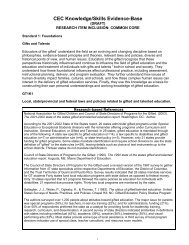2010 Pre-K-Grade 12 Gifted Programming Standards - NAGC
2010 Pre-K-Grade 12 Gifted Programming Standards - NAGC
2010 Pre-K-Grade 12 Gifted Programming Standards - NAGC
Create successful ePaper yourself
Turn your PDF publications into a flip-book with our unique Google optimized e-Paper software.
<strong>Gifted</strong> Education <strong>Programming</strong> Standard 4: Learning Environments<br />
Introduction<br />
Effective educators of students with gifts and talents create safe learning environments that foster emotional well-being, positive<br />
social interaction, leadership for social change, and cultural understanding for success in a diverse society. Knowledge of the impact of<br />
giftedness and diversity on social-emotional development enables educators of students with gifts and talents to design environments<br />
that encourage independence, motivation, and self-efficacy of individuals from all backgrounds. They understand the role of language<br />
and communication in talent development and the ways in which culture affects communication and behavior. They use relevant<br />
strategies and technologies to enhance oral, written, and artistic communication of learners whose needs vary based on exceptionality,<br />
language proficiency, and cultural and linguistic differences. They recognize the value of multilingualism in today’s global community.<br />
Standard 4: Learning Environments<br />
Description: Learning environments foster personal and social responsibility, multicultural competence, and interpersonal and<br />
technical communication skills for leadership in the 21 st century to ensure specific student outcomes.<br />
Student Outcomes<br />
4.1. Personal Competence. Students with gifts and<br />
talents demonstrate growth in personal<br />
competence and dispositions for exceptional<br />
academic and creative productivity. These include<br />
self-awareness, self-advocacy, self-efficacy,<br />
confidence, motivation, resilience, independence,<br />
curiosity, and risk taking.<br />
4.2. Social Competence. Students with gifts and<br />
talents develop social competence manifested in<br />
positive peer relationships and social interactions.<br />
4.3. Leadership. Students with gifts and talents<br />
demonstrate personal and social responsibility and<br />
leadership skills.<br />
4.4. Cultural Competence. Students with gifts and<br />
talents value their own and others’ language,<br />
heritage, and circumstance. They possess skills in<br />
communicating, teaming, and collaborating with<br />
diverse individuals and across diverse groups. 1<br />
They use positive strategies to address social<br />
issues, including discrimination and stereotyping.<br />
4.5. Communication Competence. Students with<br />
gifts and talents develop competence in<br />
interpersonal and technical communication skills.<br />
They demonstrate advanced oral and written skills,<br />
balanced biliteracy or multiliteracy, and creative<br />
expression. They display fluency with technologies<br />
that support effective communication<br />
Evidence-Based Practices<br />
4.1.1. Educators maintain high expectations for all students with gifts and<br />
talents as evidenced in meaningful and challenging activities.<br />
4.1.2. Educators provide opportunities for self-exploration, development and<br />
pursuit of interests, and development of identities supportive of achievement,<br />
e.g., through mentors and role models.<br />
4.1.3. Educators create environments that support trust among diverse<br />
learners.<br />
4.1.4. Educators provide feedback that focuses on effort, on evidence of<br />
potential to meet high standards, and on mistakes as learning opportunities.<br />
4.1.5. Educators provide examples of positive coping skills and opportunities to<br />
apply them.<br />
4.2.1. Educators understand the needs of students with gifts and talents for<br />
both solitude and social interaction.<br />
4.2.2. Educators provide opportunities for interaction with intellectual and<br />
artistic/creative peers as well as with chronological-age peers.<br />
4.2.3. Educators assess and provide instruction on social skills needed for<br />
school, community, and the world of work.<br />
4.3.1 Educators establish a safe and welcoming climate for addressing social<br />
issues and developing personal responsibility.<br />
4.3.2. Educators provide environments for developing many forms of<br />
leadership and leadership skills.<br />
4.3.3. Educators promote opportunities for leadership in community settings to<br />
effect positive change.<br />
4.4.1. Educators model appreciation for and sensitivity to students’ diverse<br />
backgrounds and languages.<br />
4.4.2. Educators censure discriminatory language and behavior and model<br />
appropriate strategies.<br />
4.4.3. Educators provide structured opportunities to collaborate with diverse<br />
peers on a common goal.<br />
4.5.1. Educators provide opportunities for advanced development and<br />
maintenance of first and second language(s).<br />
4.5.2. Educators provide resources to enhance oral, written, and artistic forms<br />
of communication, recognizing students’ cultural context.<br />
4.5.3. Educators ensure access to advanced communication tools, including<br />
assistive technologies, and use of these tools for expressing higher-level<br />
thinking and creative productivity.<br />
1 Differences among groups of people and individuals based on ethnicity, race, socioeconomic status, gender, exceptionalities, language, religion, sexual orientation, and<br />
geographical area.<br />
National Association for <strong>Gifted</strong> Children • 1331 H Street, NW, Suite 1001 • Washington, DC 20005 • 202.785.4268 • www.nagc.org<br />
9-21-10<br />
6
















